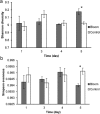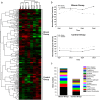A comprehensive insight into functional profiles of free-living microbial community responses to a toxic Akashiwo sanguinea bloom
- PMID: 27703234
- PMCID: PMC5050414
- DOI: 10.1038/srep34645
A comprehensive insight into functional profiles of free-living microbial community responses to a toxic Akashiwo sanguinea bloom
Abstract
Phytoplankton blooms are a worldwide problem and can greatly affect ecological processes in aquatic systems, but its impacts on the functional potential of microbial communities are limited. In this study, a high-throughput microarray-based technology (GeoChip) was used to profile the functional potential of free-living microbes from the Xiamen Sea Area in response to a 2011 Akashiwo sanguinea bloom. The bloom altered the overall community functional structure. Genes that were significantly (p < 0.05) increased during the bloom included carbon degradation genes and genes involved in nitrogen (N) and/or phosphorus (P) limitation stress. Such significantly changed genes were well explained by chosen environmental factors (COD, nitrite-N, nitrate-N, dissolved inorganic phosphorus, chlorophyll-a and algal density). Overall results suggested that this bloom might enhance the microbial converting of nitrate to N2 and ammonia nitrogen, decrease P removal from seawater, activate the glyoxylate cycle, and reduce infection activity of bacteriophage. This study presents new information on the relationship of algae to other microbes in aquatic systems, and provides new insights into our understanding of ecological impacts of phytoplankton blooms.
Figures






References
-
- Mague T. H. Extracellular release of carbon by marine phytoplankton; a physiological approach. Limnol Oceanogr 25, 262–279 (1980).
-
- Tada Y., Taniguchi A., Sato-Takabe Y. & Hamasaki K. Growth and succession patterns of major phylogenetic groups of marine bacteria during a mesocosm diatom bloom. J. Oceanogr. 68, 509–519 (2012).
-
- Zubkov M. V. et al. Linking the composition of bacterioplankton to rapid turnover of dissolved dimethylsulphoniopropionate in an algal bloom in the North Sea. Environ Microbiol. 3, 304–311(308) (2001). - PubMed
-
- Yang C. et al. Bacterial community dynamics during a bloom caused by Akashiwo sanguinea in the Xiamen sea area, China. Harmful Algae 20, 132–141 (2012).
Publication types
MeSH terms
LinkOut - more resources
Full Text Sources
Other Literature Sources

